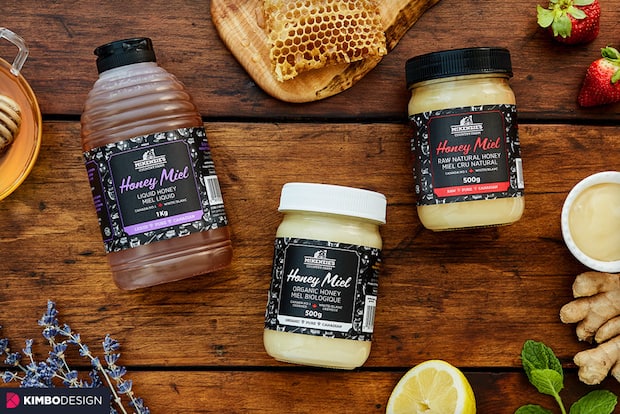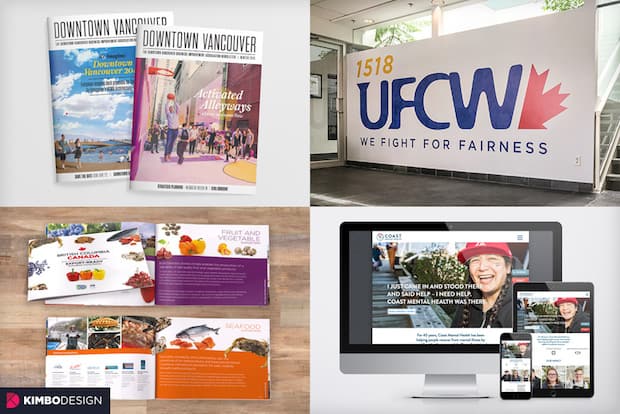Kim Pickett has been in the advertising business since 2001 and has owned KIMBO Design for over 15 years. Kim receives around ten emails per day with links and attachments to design portfolios. Emma Bullen spoke to her about what she looks for and how to create a kick-ass portfolio.
Emma Bullen: “What do you look for in a portfolio?”
Kim Pickett: “I look for a designer that matches the work that we do here at KIMBO Design and the work I have done with my signature style. If someone does approach KIMBO, they should have a tailored portfolio. Look at where you’re applying and curating your work so it fits and it’s in line. Look at your target audience. What are they going to engage with? You’re not doing it for yourself; you’re doing it for your audience. I can tell very quickly a designer applying to work at KIMBO is a fit.”
EB: “Where do you start when you’re building a portfolio?”
KP: “Start with a brief — ask yourself, “What do I want out of it? Do I want a job? Do I want to win awards?” Hone in on your purpose for creating your portfolio before you get started.
“The most important thing is having a portfolio online. People are busy. If I’m on my phone, I want to see it and be responsive. Some designers don’t know how to program. That’s okay — trade favours with a developer or use the tools that are out there and do a decent job. Add white space and let the work speak for itself. Don’t go overboard, just be clean and simple.”
EB: “How can recent design graduates showcase their potential?”
KP: “Show the layout and typography skills that are needed. There are lots of designers coming out of schools with one-two years of knowledge, and it’s not enough for a high-end design agency. You might know how to use the tools, but there has to be a finer eye for detail. Typography is key. I’ll look that more than the layout.”
“Use good photography, take photos of your work rather than trying to photoshop it. Trade favours with those students that are coming out of school, find a photographer to take photos of your work, especially your print work.”
EB: “How do I make my portfolio flow?”
KP: “When you go to an art gallery, and you walk in, what are the walls like? They’re all white; the paintings are all in line, it looks consistent and nice to look at. Look at the work and curate it, making sure it fits within your collection. Think about consistency. There’s always a way to make things consistent.”
“Create an identity with lots of white space, then get into the identity used in context. Go from a logo to how the logo looks on a website, to how it works in a magazine. For offline, you can tailor your presentation, and it can be like a music piece; there’s a subtle beginning that’s strong, but that gets more powerful. There’s a crescendo with the best work.”
EB: “How many items should I have in a portfolio?”
KP: Think quality not quantity. Too much is exhausting. Limit the amount of work that you show. If you’re going for an interview, then treat it as if it’s a presentation and script out your portfolio. I’d aim to show six to eight pieces of work in person. Online you can be more flexible, depending on the user flow and what people see.”
EB: “How often should I update my portfolio?”
KP: “Always keep it up-to-date and make it searchable. Being found online helped me when I was a freelance designer. People would find me by the work that I’d done. Keep your website up-to-date and always archive things, don’t throw them away. It’s good to have things up there, buried. You never know what someone is looking for. If you have a niche, you never know where the work is coming from.”
Tailor your presentation like a music piece; there’s a subtle beginning that’s strong, but that gets more powerful. There’s a crescendo with the best work.
EB: “What’s your pet peeve when it comes to portfolios?”
KP: “I receive about ten emails a day from designers, developers, and some writers. I’m always getting portfolios or links. I see spelling errors in portfolios, and I can tell when someone hasn’t taken the time to curate the work in that first email or the portfolio. I’ve also seen applicants who take the time to do a proper cover letter, but then use another agency’s name. It’s happened a lot.”
“Sending attachments is my pet peeve. I’d rather have a link I could click on than an attachment. What I want to see is a professionally written email and a link. It’s hard when someone’s sending you a big pdf if you’re viewing it on a phone.”
EB: “Do I need a physical portfolio as well as an online portfolio?”
KP: “A lookbook or something that you can leave with the interviewer is key. You don’t have to put everything in there, just a little bit. It’s hard when you’re a struggling student; you have to be creative.”
EB: “How can I make my portfolio stand out from the crowd?”
KP: “I can’t say that I’ve ever seen one that’s amazing. I think it’s the work more than anything else, just the simplicity of the user experience. Showcasing the work is key.
Look at famous designers that are out there, look at their portfolios and emulate them. Karim Rashid is an industrial designer who has a great online portfolio. Its look is very current, very now. You have to look up-to-date when you represent yourself online. It changes quickly, very important that designers have some coding background or some friends to help them stay current.
EB: “Should I stick to showing only client work in my portfolio?”
KP: “I’ll do a google search to see if everything lines up. I’ll take a look at the work, if the work is group work if it’s paid work. I always ask that question. It’s fine not to have paid work, but say it, so it doesn’t pass it off as though you’re cheating or lying. You always want to say what your role was.
EB: “How do I show my personality in my portfolio?”
KP: “I often see designers whose personality overshadows their portfolio. Confidence is one thing, but being cocky is off-putting. You want to be humble in your approach and relatable to where you’re working. Keep your portfolio clean and simple, don’t add too much personality. You don’t want your personal brand to clash for your work. It will throw someone off. Go greyscale and add one colour if you’re online, but limit your self-branding to showcase your work.
EB: “If you saw an opportunity, but you didn’t think your portfolio was up to scratch, would you pass or send what you have?”
KP: “Do the best you can rather than miss an opportunity. I would never miss an opportunity. Do your best to show what you have and go with it. All of us are pretty self-critical. You may not think it’s great, but you don’t actually know that. Get yourself out there. That’s what I did.”
They can find it easy and relate to it easily. Projects we’ve done in the past. Having your work photographed, up to date and responsive. Writing about your work Take notes when you’re working on the project. What is interesting that someone would want to read. It’s storytelling, make it interesting. You can even show process work in your portfolio.”
EB: “Are portfolios just for designers?”
KP: “Everyone can use the portfolio format. You can tell a story visually in any profession. Writers need portfolios — they should have their work online. PR consultants should be able to show what they have you done for a client.
Even a financial person can tell a visual story about one of their clients, visually illustrating how they helped them. Whether it’s a testimonial, or a photo of a printed handout, there’s always room to have visuals in your work, no matter what your discipline is.”


